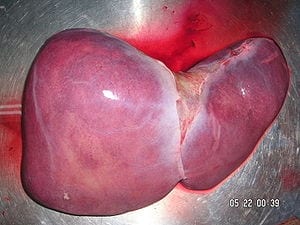
Donor organ allocation policy could be changed to nearly eliminate waitlist mortality for children —without additional risk to adult recipients.
Split liver transplantation carries no increased risk of failure in either recipient, allowing surgeons to safely save two lives from a single donated organ (graft), according to new research from Boston Children’s Hospital published online in the Journal of the American College of Surgeons.
Due to their regenerative nature, livers donated by a deceased adult or adolescent can be surgically split into two unequally sized portions; the smaller segment is allocated to a young child awaiting transplant and the larger portion to an adult.
“Infants waiting for a donor liver have the highest waitlist mortality of all liver transplant candidates, and dozens of children die each year waiting for size-appropriate organs to become available,” says Heung Bae Kim, MD,director of Boston Children’s Hospital’s Pediatric Transplant Center and lead author on the study.”If wecan increase the number of split livers to just 200 a year, which would still affect less than four percent of the total number of livers transplanted each year, it would save virtually every small child waiting for a new liver.”
Based on his recent findings, (which includes research on how well children function with split livers) Kim isadvocating for changes in how donor livers are allocated—automatically placing infants and small children at the top of the liver waitlist, thereby giving pediatric transplant surgeons the option to split the first graft to become available. Once the liver has been split, the smaller portion is transplanted into a child and the larger portion is transplanted into the next appropriate adult on the list.
Analyzing United Network for Organ Sharing (UNOS) records, Boston Children’s researchers looked at data compiled over a fifteen year period (1995-2010), studying the graft survival rates of 62,190 first-time adult deceased-donor liver transplant recipients, 889 of whom received partial grafts from a split liver transplant. The research shows that from 2002 forward thevast majority of adults who received a split graft experienced a risk of graft failure comparable to those who received a whole graft.
“After an extensive review of the data, it’s clear that in the current era, with the exception of a small, very sick population of patients, adults who receive a split graft can expect to fare as well as those who received a whole organ,” says Ryan Cauley, MD, MPH, first author on the paper. ” Because risks once associated with this technique are now negligible, if a center has a patient waiting for a liver and it has access to a split graft, there’s no reason not to accept it.”
The Latest Bing News on:
Donor organ allocation
- More people need transplants than there are organ donors. Pigs might be a solutionon May 9, 2024 at 11:09 am
Some scientists think animal organs might be a good way to increase the supply, but the science has been stalled as researchers tried to figure out how to prevent organ rejection and avoid dangerous ...
- Study reveals how gender affects liver transplant success in cancer patientson May 9, 2024 at 10:11 am
Liver transplantation is a life-saving option for those with hepatocellular carcinoma (HCC), the most prevalent type of liver cancer. Although often successful, outcomes can vary widely among ...
- Organ donation groups merge and re-brandon May 9, 2024 at 6:41 am
CINCINNATI — Kentucky Organ Donor Affiliates, Inc. (KODA) and LifeCenter Organ Donor Network (LifeCenter) recently announce the re-branding of their future combined entity as Network for Hope (NFH). T ...
- New study reveals how gender affects liver transplant success in cancer patientson May 9, 2024 at 2:32 am
A groundbreaking multicenter cohort study in China has illuminated the impact of sex on the outcomes of liver transplantation (LT) for hepatocellular ...
- New technology allowing TGH surgeons to perform more organ transplantson May 8, 2024 at 7:54 pm
In Florida, there are more than 5,000 patients and their families waiting for a call that an organ is ready for them. Tampa General Hospital has around 1,000 patients on that list.
- Diminishing the Organ Donation Wait List with Xenotransplantationon May 8, 2024 at 5:00 pm
In just the US, more than 100,000 men, women, and children are waiting for an organ transplant. According to the United Network of Organ Sharing, more than 6,000 people in the US die on an annual ...
- Keokuk man’s organ donation helps others live onon May 6, 2024 at 1:14 pm
Iowans are currently registered organ and tissue donors. 97 percent of them registered while getting their driver’s license.
- Brain-dead youth’s heart, liver & kidney save 3 liveson May 5, 2024 at 3:57 pm
A 27-year-old brain-dead man's heart, liver, and kidney were donated, saving 3 lives in Kolkata. The heart was flown to Chennai for a 5-year-old, while the liver and a kidney were transplanted locally ...
- Dispelling common myths about organ donationon May 3, 2024 at 12:20 am
Myth: Rich and famous people go to the top of the list when they need a donor organ. Fact: The rich and famous aren’t given priority when it comes to allocating organs. It may seem that way because of ...
- Why The Swiss Are Donating More Organs For Transplanton May 2, 2024 at 11:32 am
Switzerland is gradually showing greater acceptance of donating organs to other people after their deaths. This content was published on May ...
The Latest Google Headlines on:
Donor organ allocation
[google_news title=”” keyword=”donor organ allocation” num_posts=”10″ blurb_length=”0″ show_thumb=”left”]
The Latest Bing News on:
Split liver transplantation
- Not Her Too! Chicago Med's Penultimate Episode Could Spell a Tragic Outcome for Goodwinon May 9, 2024 at 12:13 pm
Dr. Sharon Goodwin has ben going through a lot on this season of Chicago Fire, and now, a new promo has fans worried about her health. What happened to Dr. Sharon Goodwin on Chicago Med? Keep reading ...
- New stem cell research may have implications for liver transplantationon May 9, 2024 at 9:20 am
A liver transplant can be life saving for people with end-stage liver disease. However, the procedure has limitations related to donor shortage, a technically challenging and invasive surgical ...
- ‘Infected blood gave my mother hepatitis C – I promised her I’d fight for justice’on May 6, 2024 at 12:25 am
Jane Fitzgerald was one of more than 30,000 people in the UK given blood products infected with HIV and hepatitis C. Her son Ronan tells i her story ...
- The Best Exercises for People With MASLDon May 2, 2024 at 5:44 pm
As fibrosis progresses, people may develop severe disease, including MASH or cirrhosis that may require a liver transplant ... which can be split into three to five sessions with two or three ...
- Outcomes of Split Versus Reduced-Size Grafts in Pediatric Liveron April 27, 2024 at 5:00 pm
Background: Split-liver transplantation, where two grafts are created from a single donor organ, is a means of overcoming donor organ scarcity. There are few data comparing outcomes of split with ...
- How liver transplant can save the lives of those suffering from liver diseaseson April 23, 2024 at 3:11 pm
paediatric liver transplantation, split liver transplantation, domino liver transplantation, cadaver liver transplantation, and auxiliary liver transplantation. Hence, one should understand when ...
- China promotes human organ donation, transplantationon April 6, 2024 at 7:16 am
The technology and quality of organ transplantation in China has also gradually improved. For example, split liver transplantation technology has been maturely applied in medical institutions in ...
- China Focus: China promotes human organ donation, transplantationon April 4, 2024 at 5:00 pm
The technology and quality of organ transplantation in China has also gradually improved. For example, split liver transplantation technology has been maturely applied in medical institutions in ...
- One Liver Saves Lives of a 2-Year-Old and a 63-Year-Old in Rare Split Transplant: 'It's a Miracle' (Exclusive)on March 14, 2024 at 5:00 pm
Cooper and Susana each received part of the same donor liver during NYU Langone’s first-ever split liver transplant. Now they are bonded for life. Mateo Salcedo / Hassenfeld Children's Hospital at NYU ...
The Latest Google Headlines on:
Split liver transplantation
[google_news title=”” keyword=”split liver transplantation” num_posts=”10″ blurb_length=”0″ show_thumb=”left”]









